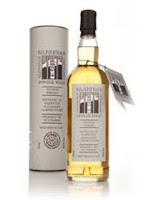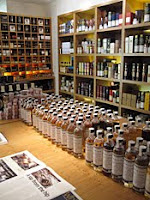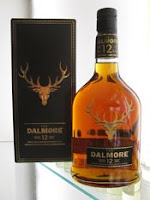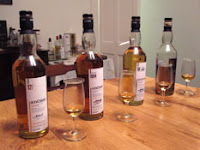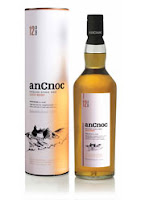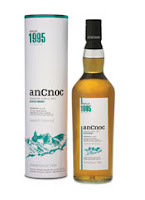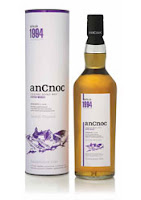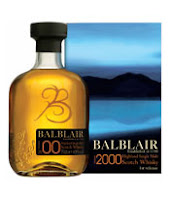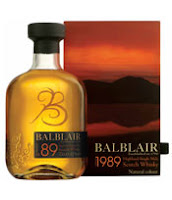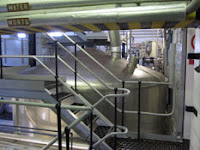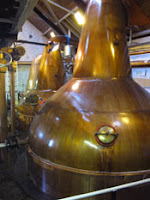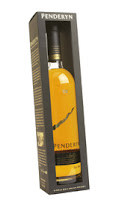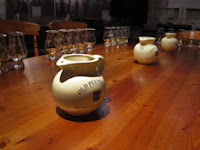
The final part of our recent tour took us to Knockdhu (pronounced
nock-doo) distillery. The tour saw us visit a trilogy of whisky distilleries owned by Inver House Distillers, which is a subsidiary of the larger Thai Beverages company. Knockdhu was founded in 1893 by a group called Distillers Company Limited (DCL), who discovered natural springs in the surrounding hills, with production of whisky beginning in October 1894. The name of Knockdhu comes from the Gaelic language and translates as '
black hill'. The single malt whisky released from the distillery is known as AnCnoc (pronounced as
a-nock) and this simply translates from gaelic as '
the hill'. Inver House took the decision to change the name of the single malts from Knockdhu in the 1990s, so that consumers would not confuse it with the Knockando distillery in Speyside.
The address of the distillery is given as Knock, near Huntly. As we discovered, addresses can sometimes be misleading! We skirted around the edge of the town of Huntly and headed off the main road in search of the village of Knock and therefore, the distillery. Over half an hour of driving passed as we drove down increasingly narrow roads in to the impending gloom of dusk and a developing fog. The two main questions being that "
we must be there soon, mustn't we?" and "
where the hell is this place?" The answer turned out to be that the village of Knock and its distillery are in the middle of nowhere, certainly not 'near' Huntly! The village has just a few houses plus the distillery and it sits at the bottom of an imposing black hill, which gives Knockdhu its name. The first impression was of a stunning location.

Our tour was taken by Gordon Bruce, the Distillery Manager of Knockdhu (pictured,
left). Gordon has worked his way up through the ranks, having started as a mash-man at Pulteney distillery back in 1986 and has come to Knockdhu via Balblair. He has held the position of Distillery Manager at '
The Knock', as he affectionately calls it, since 2006. We discover that he lives with his family in one of the few houses in the tiny village of Knock, is on call at the distillery 24/7 and that his two dogs frequent the distillery regularly - the comment being that "
they are more photogenic than anyone else who works here!" Sadly, they were not there on the day of our visit.

Knockdhu is not open to the public, so the chance to have a look around was to be a real treat. Despite this, Gordon commented that he has never turned any visitor away in his four years as Distillery Manager and has always found the time for himself or another member of staff to show them around. We begin with a short walk to the back of the distillery and pass two piles of rubble (pictured,
left). Gordon explains that these are the remains of two of Knockdhu's five warehouses, which collapsed under the weight of heavy snow last winter. They managed to save most of the maturing whisky but he gets visibly emotional as he describes the loss of 18 casks - the roof caved in and the side walls were pulled down as a result, smashing the casks. This damage equated to £150,000 worth of whisky and included casks from 1989 to 2009.
The tour begins with a rare treat - a trip to see the distillery's old kiln and the chance to go inside it! Nowadays, most distilleries do not produce their own malted barley, so the malting floors and kilns are redundant. The kiln at a distillery is housed in the pagoda structure (Knockdhu's is pictured,
below left) and these charismatic buildings give a distillery some photographic charm, but little else these days. Knockdhu's pagoda and kiln hasn't been used for around 40 years.

We firstly take a look at the large oven before moving upstairs, where Gordon opens a small doorway and beckons Matt, who happens to be first on the scene, inside. Faced with blackness and a fear of heights, Matt is reluctant - only for Gordon to reassure him with the words, "
trust me, I'm a distiller!" before patting him on the back to coax him in! Once inside, we are standing on the mesh floor where the grains once sat with the kiln oven directly below us. The inside of the structure (pictured,
above centre) is in some disrepair but plans are in place to renovate it. Gordon tells us that with a bit of work the kiln and its pagoda could function again, as everything including the triangular vent (viewed from directly below,
above right) is operational. This was a totally unique experience and was put in to perspective when we were told that the room we had stood in could hold 25 tonnes of malted barley at a time.

After a brief visit to the milling room, which includes a Porteus mill from 1964 and a state-of-the-art grain filtering machine, we move on to the mash room. This room is is dominated by the huge circular stainless steel mash tun, where the malted barley is mixed with warm water to dissolve the soluble sugars from the grain. This water is added in three stages, with each stage at a higher temperature - this helps to ensure that the maximum amount of sugars are extracted from the barley. The three temperatures at Knockdhu are approximately 63°C, then 72°C and finally 82°C. This mash tun is new, having been installed in the summer of 2009, and boasts a striking domed copper top which replicates that of their previous mash tuns. We get to see the second water being added here.

Next up is the room where the fermentation takes place. This houses six large wooden tanks, known as washbacks. Here they take the sugary liquid from the mash tun (called wort) and add yeast to create alcohol. Each washback holds 21,500 litres of wort and to this they add 100 litres of liquid distillers yeast. The final product is called 'wash' and this has an alcohol level of around 8% ABV - the equivalent to a strong beer. It is interesting to hear that Gordon finds this the most interesting part of the whole whisky making process. The reason is that it is the one part that is hardest to control as you are relying on nature to do the job for you. In contrast everything else can be controlled by the workers - milling, mashing, distilling etc. We take the opportunity to try the 'wash', which is reminiscent of a malty, fruity ale.
It is only after Gordon's comments above on the fermentation and his emphasis on the skill of the distillery workers, that something becomes obviously apparent. This 'something' is confirmed in the still house - Knockdhu has no computers operating any stage of its whisky making process. Computers are now commonplace in many distilleries and control all aspects of production, so to see a distillery that is totally reliant on the traditional skills of its workers is unusual and refreshing. One of our group points this out and Gordon shows us the only 'computer' in the distillery ... a calculator!
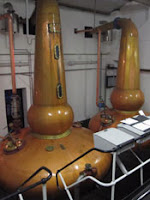
The still room at Knockdhu is on the small side but feels much less cramped than those at
Balblair and
Pulteney. Here the stills (pictured,
left) have more room and have flatter than normal bases, in comparison to many distilleries that have more bulbous ones. This forces the alcohol vapours to travel up tall narrow neck of the stills and helps to ultimately produce the light, fresh style of spirit that Knockdhu is well regarded for. The vapours then move along the horizontal lyne arms and out through the side wall of the still room in to a worm tub. Worm tubs are large tanks of cold water through which a spiraled copper pipe passes and this condenses the alcohol vapour back to a liquid spirit. Few distilleries still have worm tubs these days, preferring condensing units. Knockdhu is unique in the Scottish whisky industry as it is the only one to have both stills connected to the same worm tub. Sadly, it was dark by this point so we could not go up and see the coiled piping and water inside the worm tub properly.
The darkness and ever increasing fog prevented us from having a look in one of the remaining warehouses but Gordon then took us back to the offices, where he took us through a tasting of some of the whiskies bottled under the AnCnoc name. The brief tasting notes for these whiskies will follow shortly in a separate post. A massive thanks goes to Gordon for his time, insight, information and hospitality on our visit. We highly recommend a visit to this fascinating traditional whisky distillery and remember, you will never be turned away ...
 The isle of Jura's only distillery
The isle of Jura's only distillery
